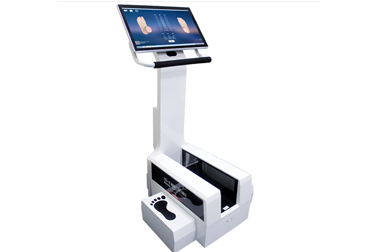Application of 3D foot scanner in medical rehabilitation
I. Accurate diagnosis and dynamic evaluation
Foot structure abnormality detection
Through millimeter-level three-dimensional modeling technology, structural abnormalities such as arch collapse and metatarsal deformity can be quickly identified, providing quantitative diagnostic basis for diseases such as flat feet and diabetic foot.
Combined with dynamic pressure distribution data (such as plantar force changes during the gait cycle), analyze foot biomechanical defects and guide rehabilitation program design.
Long-term tracking and efficacy monitoring
Regular scanning generates foot morphology change curves, quantitatively evaluates the effects of orthopedic devices or rehabilitation training, and dynamically adjusts intervention strategies.
II. Customization of personalized rehabilitation aids
Orthopedic insoles and prosthetic adaptation
For patients with flat feet, high arch feet, etc., based on arch height and pressure distribution data, 3D printed orthopedic insoles that fit the foot curve are designed to effectively disperse plantar pressure and reduce the risk of diabetic foot ulcers.
Customize high-precision prosthetic sockets for amputees to improve the balance of residual limb force and reduce skin wear and pain.
Orthopedic external fixation brace
Through fast 3D scanning and 3D printing technology, external fixation braces that fit the bone morphology are customized for fracture patients to improve reduction accuracy and shorten the recovery period.

III. Surgical planning and postoperative rehabilitation
Orthopedic surgical guide design
Reconstruct the joint 3D model based on CT or scanning data, design a personalized osteotomy guide, control the error of complex surgeries such as knee replacement to the millimeter level, and reduce the risk of intraoperative bleeding and nerve damage.
Postoperative gait correction
Combined with dynamic gait analysis (such as foot movement trajectory, pressure peak point), formulate targeted rehabilitation training plans to help patients restore their natural gait.
IV. Chronic disease management and prevention
Diabetic foot intervention
Through foot scanning
Identify early ulcer risk areas, customize 3D printed orthopedic insoles to improve blood circulation and reduce the probability of amputation.
Dynamically monitor foot skin deformation and warn of tissue damage caused by abnormal plantar pressure.
- Technology Integration and Future Trends
AI prediction and telemedicine: Scanning data is combined with AI algorithms to predict foot health risks (such as the probability of diabetic foot ulcers) and support cross-regional rehabilitation management through cloud collaboration.
Low-cost popularization: Portable devices (such as 15kg hosts) promote the technology to community clinics, benefiting more patients with chronic diseases.
3D foot scanners are reshaping the precision path of medical rehabilitation through precise measurement, personalized assistive device customization and dynamic monitoring. Its application in orthopedic surgery, chronic disease management, sports injury rehabilitation and other scenarios has significantly improved efficacy and reduced medical costs. With the iteration of technology, the future will further promote the transformation from “empirical medicine” to “data-driven medicine”

Pingback: Foot Scanner_Foot Shape Scanner_Gait Analysis Equipment_Gait Analyzer Manufacturer_Gait Analysis System